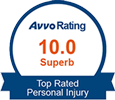Central Illinois Since 1895
Car Accident Fractures
Fractures are defined as breaks in the bone. Fractures are the result of trauma to the bone, such as the impact from a motor vehicle accident. While some fractures are very easy to identify at the scene of a car accident, other types of fractures may be harder to ascertain and require the use of radiographic imaging and physical examination by a physician.
Most Common Fractures Resulting From Car Accidents
- Arm Fractures
- Leg Fractures
- Spinal Fractures
Arm Fractures
The human arm contains 3 bones: the humerus, the radius and the ulna. The humerus, which is a large bone, connects the elbow to the shoulder and fractures and breaks of this bone can be painful and severe. The radius connects the elbow to the wrist above the thumb. The ulna connects the elbow to the wrist above the pinky finger.
Common Fractures to the Arm as a Result of a Motor Vehicle Accident:
- Closed Fracture (Broken bone does not pierce the skin.)
- Open/Compound Fracture (Broken bone pierces the skin.)
- Complete Fracture (Bone is broken in two pieces with a clean break.)
- Incomplete Fracture (Bone is cracked but is not two pieces.)
- Comminuted Fracture (Broken bone breaks into several pieces.)
- Displaced Fracture (Broken bone fragments are not in alignment at the site of the fracture.)
Leg Fractures
The human leg contains 3 bones: the femur, the tibia and the fibula. The femur (thigh bone) connects the pelvis to the lower leg bones. The tibia (shinbone) connects the knee to the ankle bone. The fibula (calf bone) connects to the tibia and forms the lateral part of the ankle the wrist.
Common Fractures to the Leg as a Result of a Motor Vehicle Accident:
- Closed Fracture (Broken bone does not pierce the skin.)
- Open/Compound Fracture (Broken bone pierces the skin.)
- Complete Fracture (Bone is broken in two pieces with a clean break.)
- Incomplete Fracture (Bone is cracked but is not two pieces.)
- Comminuted Fracture (Broken bone breaks into several pieces.)
- Displaced Fracture (Broken bone fragments are not in alignment at the site of the fracture.)
Spinal Fractures
The spinal column is comprised of 33 bones called vertebrae that are stacked upon one another. The spinal column makes up 4 different regions: the cervical (neck), the thoracic (check), the lumbar (lower back) and the sacral (pelvic). The vertebrae serves two purposes: (1) protection of the spinal cord which houses nerves that carry messages from the brain to the body and (2) creation of shape to an individual’s neck (the cervical spine), mid-back (the thoracic spine) and the lower back (the lumbar spine).
Common Spinal Fractures as a Result of a Motor Vehicle Accident:
- Axial Burst Fracture (Broken vertebra loses height in the front and back.)
- Compression Fracture (Front of vertebra breaks and loses heigh but the back of the vertebra does not lose height.)
- FlexionDistraction Fracture (Vertebrae are pulled apart.)
- Fracture/Dislocation (Soft tissue or bone becomes unstable resulting in one vertebra moving off of an adjacent vertebra.)
- Transverse Process Fracture (Sudden and extreme trauma resulting in rare but stable fracture of a vertebra.)
Surgical Treatment for Spinal Fractures
- Spinal Fusion (spondylodesis or spondylosyndesis) – Joining of two or more vertebrae which prevents movement between the two fused vertebrae. There are many types of spinal fusions which involve different techniques such as bonegrafting which may be through autograft (bone from the patient), allograft (bone from a donor), or through artificial bone substitutes. Hardware such as cages, plates and screws may be utilized.
- Vertebroplasty – Bone cement is injected into compressed or fractured vertebrae for stabilization.
- Kyphoplasty – A tube is inserted into the vertebral column using X-Ray guidance and then inserting a bone tamp which is inflated. The inflated bone tamp is a tool used to restore the vertebral disc back to its original height. Think of it like a “spacer.” This spacer creates a cavity of sorts that is then filled with bone cement for strength and stability.
- Implantation of artificial discs where vertebral discs have been damaged. This provides stability and can help to eliminate pain.
It is imperative that victims of a motor vehicle collision seek necessary medical attention as well as obtain radiographic imaging to help pinpoint the location and extent of fracture. Additional imaging such as CT scans or MRIs may help to provide more specific information as to the severity of the fracture.









